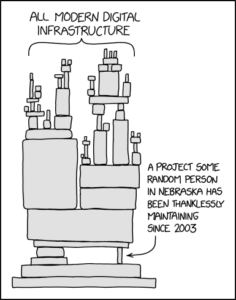There’s no problem that the federal government throwing money at it can’t make worse.
Today’s example: Democrats pimping billions in taxpayer subsidies for the semiconductor industry.
As the COVID-19 pandemic exacerbates supply chain backlogs and global computer chip shortages
Correction: It wasn’t the pandemic itself, it was government lockdowns and other overeactions that did that.
Democratic leaders in Congress as well as President Joe Biden want Congress to fast track a $250 billion bill to develop American independence from China and other competitors in chip manufacturing.
The Capital Region – home to SUNY Polytechnic Institute, the only publicly owned 300-millimeter semiconductor research and development center in the U.S. – stands to reap significant benefits from the enactment of Senate Majority Leader Charles E. Schumer’s multi-billion dollar bill, which he envisions as a direct investment in his home state’s economy.
“Sen. Schumer wrote this legislation with upstate New York always at the forefront of his mind,” Schumer’s spokeswoman Allison Biasotti said. “We are already seeing the excitement in major employer expansions and thousands of jobs on the horizon from GlobalFoundries’ planned expansion (in Malta) and (his) push for Albany Nanotech to be a hub for the National Semiconductor Technology Center.”
A focal point of the bill, which the New York Democrat co-sponsored with Sen. Todd Young, R-Ind., is a historic $52 billion investment in stateside semiconductor research and development to address a global chip shortage plaguing the automotive industry.
Lawmakers began to focus more on the low domestic production of semiconductors when the COVID-19 pandemic cut off supplies from overseas. Without access to chips, several automakers shut down their production lines, and manufacturers of essential medical devices and consumer electronics struggled to meet increasing demand.
Roughly 12 percent of the world’s semiconductors are manufactured in the United States, down from 37 percent in 1990, according to the Semiconductor Industry Association.
Either these stats are false or misleading (probably the latter). The most recent stats I can find show that the United States has some 47% of the semiconductor market. It’s possible that the 12% refers to the entire worldwide number of individual chips produced, including discrete components (transistors, resistors, etc.). Those are indeed semiconductors, but they’re produced on old amortized fabs (inside the industry these are referred to as “jelly bean factories”) and sell for pennies a piece (or less). If you’re already in that industry, those old fabs make small, steady profits every year, but nobody jumps into that business with new fabs.
The chips China make are generally either: A.) Cheap, or B.) intended for their internal market. No one sends cutting edge chips to be fabbed in China because they don’t have the tech to do it and everyone know they’ll steal your designs and crank out knock-offs on the sly whenever possible. China’s semiconductor industry is mostly smoke and mirrors all the way down.
Semiconductor subsidies have all the hallmarks of a classic Washington boondoggle: The wrong action at the wrong time for the wrong problem.
First, there are already signs that the automotive semiconductor crunch is easing, thanks not to the Biden Administration but to the actions of the free market.
Second, the shortage wasn’t the result of a “chip shortage,” it was the result of “a lack of available foundry wafer starts.” Automakers cancelled their orders for display drivers when it looked like Flu Manchu lockdowns were going to depress the economy for a while, and were caught off-guard by the V-shaped recovery under Trump, and got sent to the back of the line to get their product fabbed after they changed their mind. Remember, just about all foundries are running flat-out 24/7/365, pausing only to switch to different chips for different customers. There’s no slack in the system, and those wafer starts are already spoken for (and possibly paid for) by other customers well in advance. Just as nine woman can’t give birth to a fully grown baby in one month, you can’t just “make chips quicker” in an existing fab.
Third, remember that cutting edge semiconductor fabs are hideously expensive. Moore’s second law states that the cost of a new, cutting edge semiconductor plant doubles every four years. Samsung’s planned fab in Taylor, Texas is going to cost $17 billion.
Fourth, if you go to a random semiconductor company and go “Here’s 20 billion! Go build a state-of-the-art 5nm wafer fabrication plant!”, then:
A.) You’re looking at a very minimum of 2-3 years before the first production wafer comes off the line. You can’t just take an existing building and turn it into a fab, it has to be specially built from the ground up with exacting standards for cleanroom air filtering, concrete slab level uniformity, etc. And 2-3 years is probably the lead time to get an ASML EUV stepper.
B.) Unless you’re TSMC, Samsung or (maybe) Intel, the answer is probably “Uh, we’ll try, but no promises,” because those three companies are the only ones that actually having wafer fabs running 10nm or smaller process nodes. GlobalFoundries, mentioned in the article, has Fab 8 in Malta, NY, running 14nm, which is not horribly far off the state-of-the art, but not good enough to fab the really cutting-edge chips demanded of companies like Apple, NVIDIA, etc. Tiny problem: In 2018, GlobalFoundries stopped all work on 7nm development.
The contract maker of semiconductors decided to cease development of bleeding edge manufacturing technologies and stop all work on its 7LP (7 nm) fabrication processes, which will not be used for any client. Instead, the company will focus on specialized process technologies for clients in emerging high-growth markets. These technologies will initially be based on the company’s 14LPP/12LP platform and will include RF, embedded memory, and low power features.
So it was too hard a game for them to play, but with a big heap of taxpayer subsidies, I’m sure they’d be willing to give it another go.
Of course, you don’t need a cutting edge fab to build display drivers. Bosch just opened a $1.2 billion, 65nm fab in Dresden to do just that. But you don’t need subsidies to build trailing edge fabs.
$250 billion in taxpayer subsidies wouldn’t get you a single additional wafer start this year, and probably would accomplish little more than channeling money to politically connected firms and sticky pockets in a state (New York) that no one wants to build fabs in any more because of high costs, high taxes and union rule requirements.
It’s a bad idea congress should reject.

